Estimated Reading Time: 15 minutes
Introduction to the Basics of IPSec
IPSec (Internet Protocol Security) is a suite of protocols designed to secure communications over IP networks. It offers encryption and authentication for both IPv4 and IPv6, ensuring the confidentiality, integrity, and authenticity of data during transmission. The aim of IPSec is to protect data from unauthorized access, eavesdropping, tampering, and other forms of attacks.
Originally developed to address security issues in internet communications, IPSec's evolution traces back to the 1990s. As the internet became more widespread, the accompanying security challenges grew increasingly prominent. To tackle these challenges, the IPSec standards were established, becoming one of the key technologies for securing internet communications.
Today, IPSec is widely used in virtual private networks (VPNs) for enterprises, government agencies, and individuals, effectively securing network layer data transmission. By establishing encrypted tunnels through IPSec, organizations or individuals can ensure the security of their data as it traverses the internet, protecting against cyber attacks and unauthorized access.
Structure of IPSec
IPSec consists of the following protocols:
- AH (Authentication Header) provides connectionless data integrity and authentication of data origin, as well as protection against IP header modification attacks and replay attacks.
- ESP (Encapsulating Security Payload) offers confidentiality, connectionless data integrity, data origin authentication, anti-replay services (a form of partial sequence integrity), and limited traffic flow confidentiality.
- ISAKMP (Internet Security Association and Key Management Protocol) offers a framework for authentication and key exchange. The actual authentication key material is supplied by manually configured pre-shared keys, Internet Key Exchange (IKE and IKEv2), Kerberized Internet Negotiation of Keys (KINK), or IPSECKEY DNS records. Its purpose is to generate Security Associations (SAs), including the set of algorithms and parameters required to perform AH and/or ESP operations.
IPSec Messages
IPSec messages are divided into two types: AH and ESP.
Authentication Header
AH operates directly over IP, using IP protocol number 51.
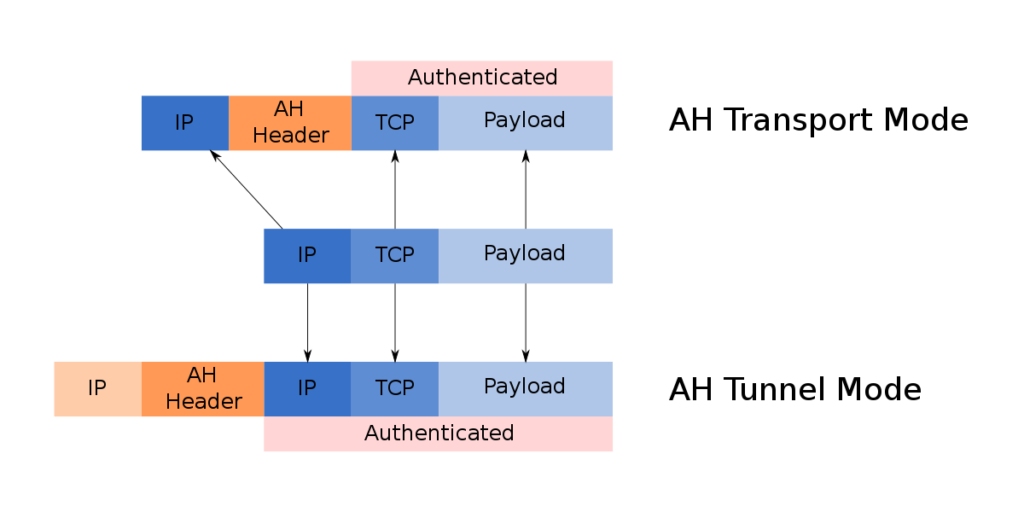
The format of the AH message is as follows:

- Next Header (8 bits) indicates the type of the upper-layer protocol being protected, drawn from the IP Protocol Numbers list.
- Payload Length (8 bits) measures the length of AH in multiples of 4 bytes minus 2. Under IPv6, the AH header is in multiples of 8 bytes.
- Reserved (16 bits) is reserved for future use (currently set to zero).
- SPI (Security Parameter Index, 32 bits) is a negotiated arbitrary value used by the receiver to identify the associated Security Association (SA).
- Sequence Number (32 bits) is an incrementing sequence number (increasing by 1 for each packet sent) to prevent replay attacks. When replay detection is enabled, the sequence number is never reused. A new SA must be negotiated before reaching the maximum value of the sequence number.
- ICV (Integrity Check Value, multiple of 32 bits) is a variable-length check value. It's used for padding to accommodate the 8-byte increments for IPv6 or 4-byte increments for IPv4.
Encapsulating Security Payload
ESP operates directly over IP, using IP protocol number 50.
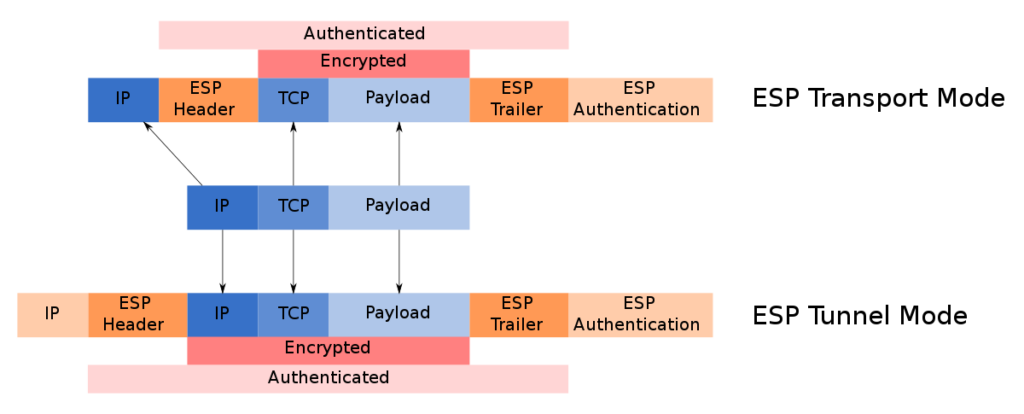
The format of the ESP message is as follows:

- SPI (Security Parameter Index, 32 bits) is a negotiated arbitrary value used by the receiver to identify the Security Association (SA).
- Sequence Number (32 bits) is an incrementing sequence number (increasing by 1 for each packet sent) to prevent replay attacks. Each SA has its own separate counter.
- Payload data (variable length) contains the protected contents of the original IP packet, with the type of protected content indicated by the Next Header field.
- Padding (0-255 bytes) is used for encryption, to extend the payload data to a size that fits the encryption's cipher block size, and to align the next field.
- Pad Length (8 bits) indicates the size of the padding.
- Next Header (8 bits) specifies the type of the next header. Its value is taken from the IP Protocol Numbers list.
- ICV (Integrity Check Value, multiple of 32 bits) is a variable-length check value. It aligns to the 8 bytes for IPv6 or 4 bytes for IPv4 and may include padding.
IPSec Operating Modes
IPSec supports two operating modes: Transport Mode and Tunnel Mode.
- Transport Mode typically encrypts or authenticates only the data of the IP packet. Since the IP header is not modified or encrypted, the routing path remains unchanged; when using AH, IP addresses cannot undergo Network Address Translation (NAT) as it would invalidate the hash value. The transport and application layers are always protected by hashing, thus they cannot be modified, including port numbers and more.
- Tunnel Mode encrypts and authenticates the entire IP packet, which is then encapsulated into a new IP packet with a new outer IP header. Tunnel mode is used to create communication between VPN sites, including host-to-network and host-to-host communications.
IPSec Encryption Algorithms
Common encryption algorithms used in IPSec include:
Symmetric Encryption Algorithms:
- AES (Advanced Encryption Standard): A widely used symmetric encryption algorithm that supports key lengths of 128 bits (AES128), 192 bits (AES192), and 256 bits (AES256).
- DES (Data Encryption Standard): An older symmetric encryption algorithm that is now considered less secure due to its short key length (56 bits) and is rarely used.
- 3DES (Triple Data Encryption Standard): An enhanced version of DES that improves security by applying DES three times.
Key Exchange Algorithms:
- Diffie-Hellman (DH): A key exchange protocol based on the discrete logarithm problem, used to establish a shared secret between two parties.
Authentication Algorithms:
- RSA (Rivest–Shamir–Adleman): An asymmetric encryption algorithm that uses a pair of keys (public and private) for encryption and decryption.
- PSK (Pre-Shared Key): An authentication method based on a pre-shared key that does not require the use of public and private keys; instead, a shared secret is pre-configured on both ends.
- ECDSA (Elliptic Curve Digital Signature Algorithm): A public-key encryption technique based on elliptic curve theory.
IPSec primarily uses symmetric encryption for encrypting data during transmission, while asymmetric encryption is mainly used during the key exchange (IKE) phase.
Security Associations (SA)
IPSec uses Security Associations (SAs) to establish and manage encryption and authentication parameters. An SA is a set of security parameters between two communicating entities, including encryption algorithms, keys, hash algorithms, and more.
IPSec SAs are established through the Internet Security Association and Key Management Protocol (ISAKMP). ISAKMP implements SAs via manual configuration of pre-shared keys, Internet Key Exchange (IKE and IKEv2), among other methods.
To determine how packets should be protected, IPSec uses the Security Parameter Index (SPI), which acts as an index to the Security Association Database (SADB), combined with the destination address in the packet header, to uniquely identify the SA for a packet.
A similar process is executed for both outbound and inbound packets, thus IPSec communication requires at least two SAs (one for inbound traffic and one for outbound traffic). IPSec commonly uses the Internet Key Exchange (IKE) protocol to establish, negotiate, and manage SAs.
Internet Key Exchange (IKE)
In IPSec, the IKE protocol operates over UDP port 500 for initiating and responding to negotiations. In NAT scenarios, it communicates over UDP port 4500.
IKEv1 and IKEv2
IKEv1 includes two phases: IKE phase 1 and IKE phase 2.
-
IKE Phase 1
The goal of IKE Phase 1 is to establish a secure, encrypted channel for secure communication between two entities. This phase primarily involves authenticating the parties and negotiating a shared session key for encrypting communications in IKE Phase 2. There are two modes in Phase 1: Main Mode and Aggressive Mode, where Main Mode offers better security, but Aggressive Mode is faster.
After completing Phase 1, the parties establish an IKE SA, a secure channel dedicated to IKE messaging itself, not for protecting IPsec data transmission. -
IKE Phase 2
The purpose of IKE Phase 2 is to negotiate IPsec SA parameters for protecting IP packets, using the secure channel established in Phase 1. This phase typically employs Quick Mode exchanges.
Upon completion of Phase 2, an IPsec SA for actual data transmission is established. This SA is unidirectional, thus two SAs are usually set up, one for inbound data and another for outbound data.
IKEv2 improves upon IKEv1 by offering enhanced security and a more efficient SA negotiation mechanism. It streamlines the protocol into a single phase that establishes the IKE SA and negotiates the IPsec SA simultaneously. IKEv2 also introduces several enhancements, such as support for NAT traversal, EAP authentication, and automatic reconnection after disconnections.
IPSec Workflow
Communication Process
-
Identifying "Interested Traffic". Upon receiving a packet, network devices typically match the packet's quintuple (source IP, destination IP, source port, destination port, and protocol) with the IPSec policy to determine if the packet should be transmitted through the IPSec tunnel. Traffic that needs to be transmitted through an IPSec tunnel is often referred to as "interested traffic".
-
Negotiating Security Associations (SA). An SA represents an agreement between two communication parties on certain negotiated elements, such as the security protocols used, the encapsulation mode for data transmission, the encryption and authentication algorithms adopted, and the keys for data transmission. Secure data transmission can only proceed once an SA is established between the two parties.
After identifying interested traffic, the local network device initiates SA negotiation with the remote network device. During this phase, the parties negotiate and establish an IKE SA (for identity verification and key exchange) through the IKE protocol, and then, based on the IKE SA, they negotiate and establish an IPsec SA (for secure data transmission). -
Data Transmission. Once the IPsec SA is successfully established, both parties can transmit data through the IPsec tunnel.
To ensure the security of data transmission, IPSec encrypts and authenticates the data using the AH or ESP protocol during this phase. The encryption mechanism ensures data confidentiality, preventing data from being intercepted during transmission; the authentication mechanism ensures data integrity and authenticity, preventing data from being spoofed or altered.

The IPSec sender encrypts the message using the encryption algorithm and key, encapsulating the original data. Then, both the sender and receiver process the encrypted message with the same authentication algorithm and key to obtain the Integrity Check Value (ICV). If the ICVs calculated by both ends match, it indicates that the message has not been altered during transmission, and the receiver decrypts the authenticated message; if the ICVs do not match, the message is discarded. -
Tunnel Teardown. Typically, session aging between communication parties signifies the completion of data exchange. Therefore, to conserve system resources, the tunnel between the parties is automatically deleted after a certain period of inactivity.
IPsec Traffic Matching
In configuring IPsec tunnels, ensuring that the configurations for interested traffic on both ends match is crucial. For example, if Site A's addresses are 10.0.1.0/24 and 10.0.2.0/24, and Site B's address range is 10.10.10.0/24, then to ensure compatibility and the correct establishment of the tunnel:
- The policy at Site A (local) should define traffic from 10.0.1.0/24 and 10.0.2.0/24 to Site B's destination subnet 10.10.10.0/24.
- Conversely, Site B’s (remote) policy should reflect this configuration in the opposite direction. Hence, Site B needs to define 10.10.10.0/24 to Site A's corresponding 10.0.1.0/24 and 10.0.2.0/24, preferably not using 10.10.10.0/24 to Site A's 10.0.0.0/22.
Aggregating multiple Class C addresses (e.g., 10.0.0.0/24 - 10.0.3.0/24) into a larger subnet might lead to SA negotiation failures due to configuration inconsistencies, so it's crucial to align policies on both sides.

For example, Router-1 configures two detailed ACLs, establishing two outbound SAs (since no active traffic, no IPsec SA has been established yet).
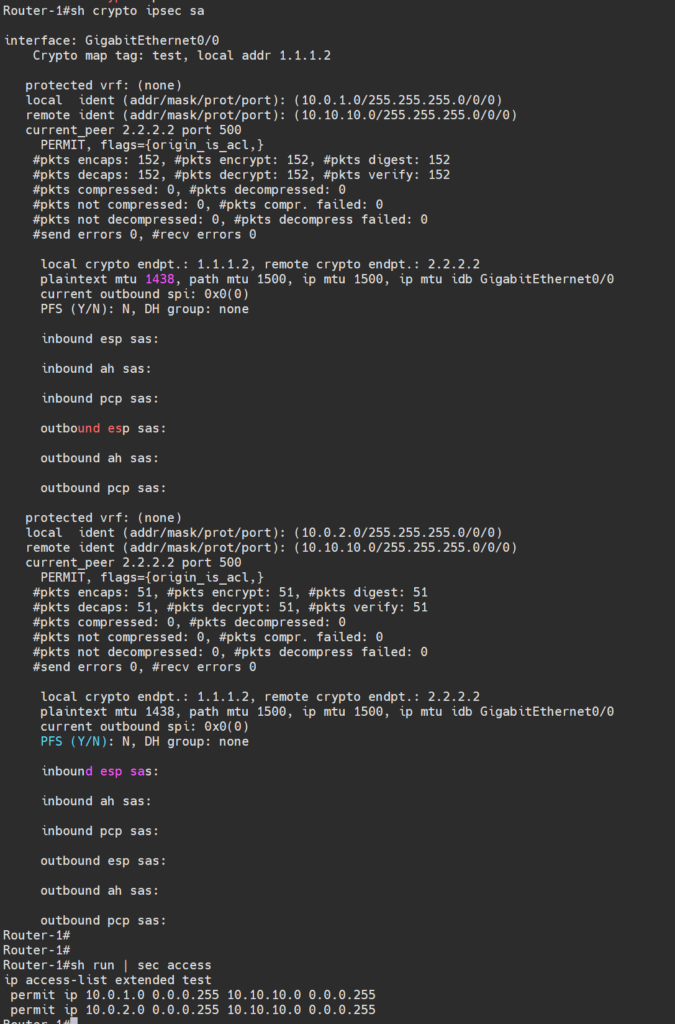
Router-2 configures an aggregated subnet, thus establishing only one outbound SA.
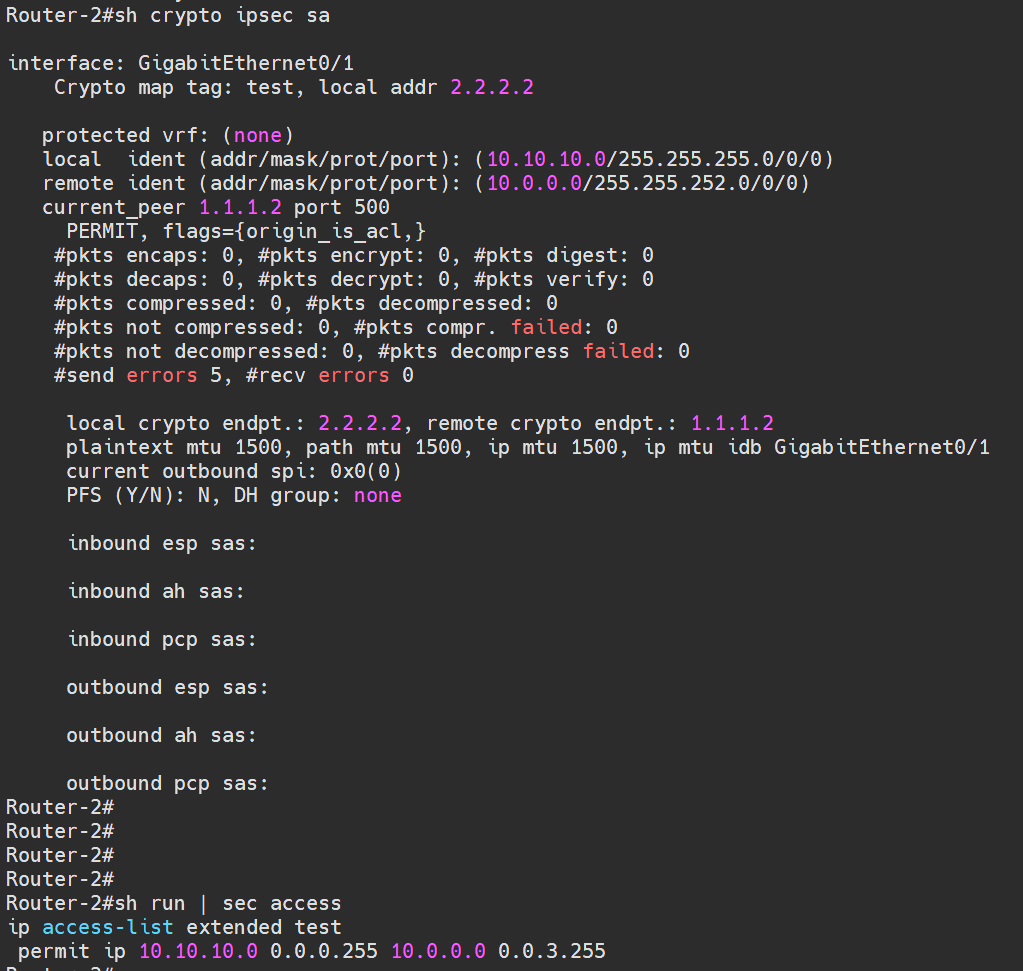
When VPC10 (10.10.10.10) -> VPC2 (10.0.2.10),
Router-2 initiates an outbound SA negotiation based on its interested traffic configuration:
- Source address: 10.10.10.0/24
- Destination address: 10.0.0.0/22
- SPI: TBD
Router-1 finds this doesn't match its interested traffic, leading to unsuccessful negotiation and inaccessible communication.
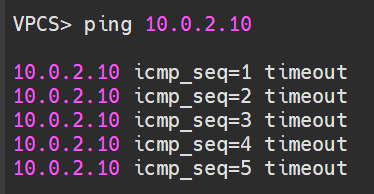
Conversely, when VPC2 (10.0.2.10) -> VPC10 (10.10.10.10), Router-1 initiates an outbound SA based on the detailed 10.0.2.0/24 to 10.10.10.0/24:
- Source address: 10.0.2.0/24
- Destination address: 10.10.10.0/24
- SPI: 0x77716905
Router-2 matches this subnet with its interested traffic and successfully negotiates, establishing the corresponding SA.

Checking Router-1 shows that the corresponding IPsec SA is active, with both outbound and inbound successfully negotiated.
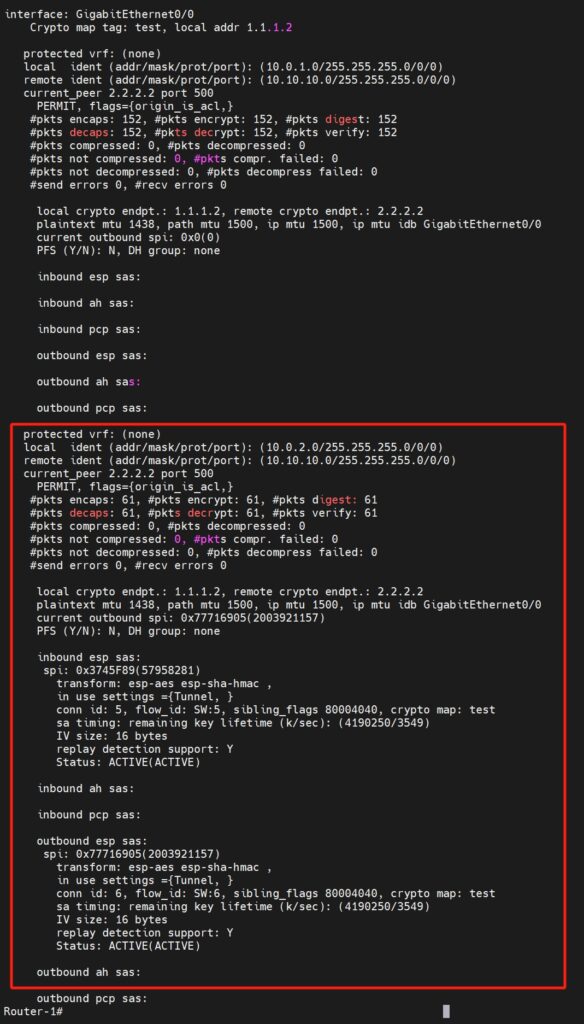
Similarly, Router-2 shows that after matching the interested traffic, an IPsec SA is created with negotiated inbound and outbound SPIs matching those of Router-1.
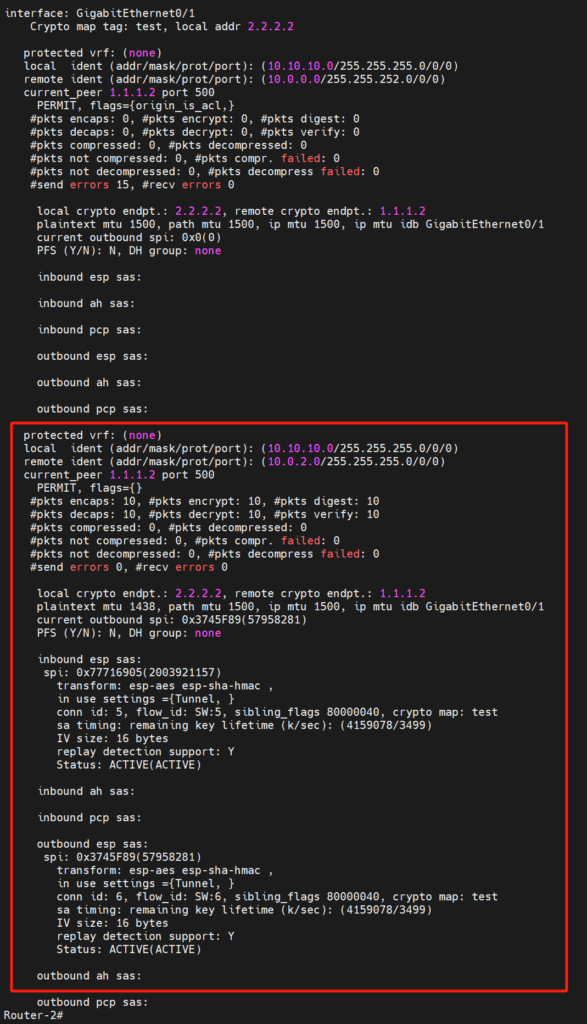
Subsequently, attempting access from VPC10 (10.10.10.10) -> VPC2 (10.0.2.10) again, communication is successful through the newly established IPsec SA.
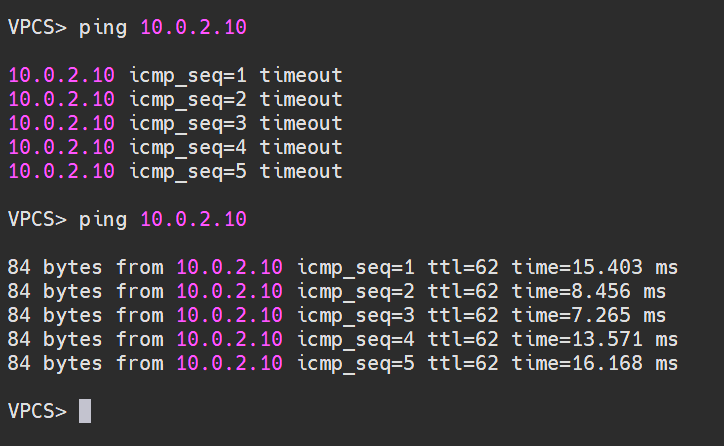
Therefore, when configuring IPsec in production environments, it's vital to maintain consistent configurations on both ends to avoid issues that could render IPsec unusable.
Summary
While IPSec might seem complex, involving numerous protocols and a variety of encryption algorithms, in essence, you don’t need to delve too deeply into how it conducts secure negotiations or how the encryption algorithms encrypt data. It's more important to understand the process of tunnel establishment and the procedures necessary for internal data to communicate effectively.
With this knowledge, you should be better equipped to understand what is required to successfully establish an IPSec site, and when maintenance issues arise, how to narrow down and pinpoint the problem.
Hopefully, the explanation provided in this article is clear enough to deepen your understanding of IPSec.
Useful Tools
For calculating the overhead and effective payload size in an IPSec packet, you might find the following online tools helpful:
References
- Cisco's Guide on IP Security: Cisco IPsec Provisioning Guide
- The Internet Key Exchange (IKE) protocol (RFC 2409): RFC 2409
- Wikipedia article on IPsec: IPsec on Wikipedia
- Huawei Support on IPsec: Huawei IPsec Support Document

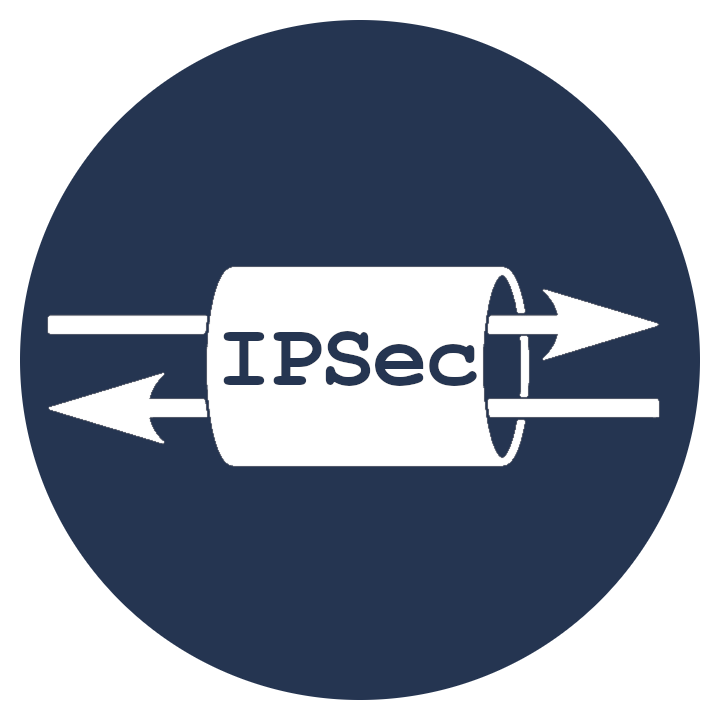
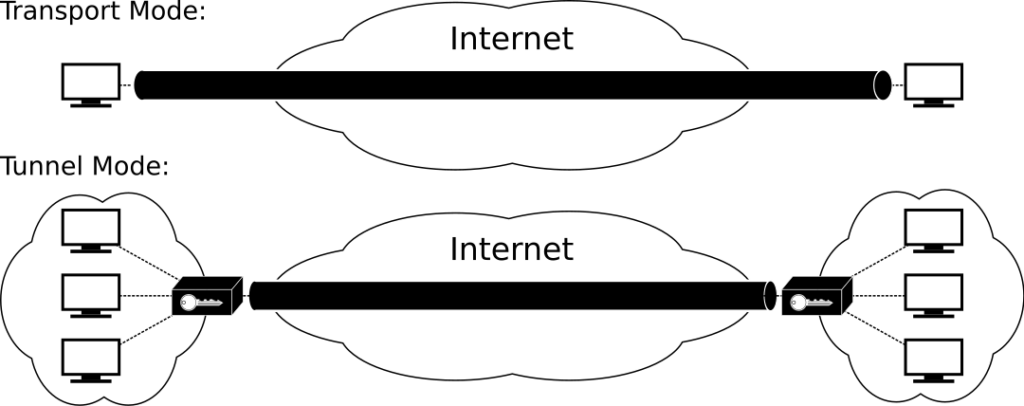
Hey would you mind letting me know wbich webhost you’re utilizing?
I’ve loaded your blog in 3 different internet browsers and I must say this bllog loads a lot faster
then most. Can you suggest a good hosting provider
at a reasonable price? Thank you, I appreciate it!
Also visit my blog – 61c31183E3715.Site123.Me
I’m using AWS and have deployed this blog with WordPress. AWS offers a 1-year free tier, but be careful as some features may not be included in the free tier.
If you’re interested in a hosted blog, you can also use the one provided by GitHub.
BTW, your blog seems already deleted and not available.
When I originally commented I clicked the “Notify me when new comments are added”
checkbox and now each time a comment is added I get
four emails with the same comment. Is there any way you can remove people from that service?
Appreciate it!
That’s strange because I didn’t add the “Notify me” checkbox, only the option to “Save my name, email, and website in this browser for the next time I comment.” I’m not entirely sure how you set that up.
Good article.
THX!
First off I would like to say great blog! I had a quick question which I’d like to ask
if you do not mind. I was interested to know how you center yourself and clear your head
prior to writing. I’ve had a tough time clearing my mind in getting my thoughts out there.
I truly do take pleasure in writing however it just seems like the first
10 to 15 minutes are usually lost simply just trying to figure out how to begin.
Any recommendations or hints? Thanks!
Thank you for your kind words! I’m glad you’re enjoying the blog. As for your question, I totally understand how challenging it can be to clear your mind before writing. Here’s what works for me:
1. Create a Routine: I find that having a consistent pre-writing routine helps. It could be as simple as making a cup of tea or taking a short walk. This tells my brain that it’s time to switch into “writing mode.”
2. Freewriting: Sometimes, I start with freewriting—just jotting down anything that comes to mind, without worrying about structure or making sense. This helps loosen up my thoughts and reduces the pressure of crafting the “perfect” first sentence.
3. Looking back at the articles I’ve written always gives me a sense of accomplishment, and that feeling fuels my motivation to keep writing more and creating new content.
Writing is a process, so don’t be too hard on yourself for needing a little time to get going. Those first few minutes are often where your mind is getting ready to dive deeper into creativity.
Happy writing! 😊
This design is incredible! You obviously know how to keep a
reader entertained. Between your wit and your videos, I
was almost moved to start my own blog (well, almost…HaHa!) Great job.
I really loved what you had to say, and more than that, how you presented it.
Too cool!
Hello, I enjoy reading through your article. I like to write a little comment to support you.
I pay a quick visit daily some websites and websites to
read articles, however this webpage provides feature based content.
Woah! I’m really digging the template/theme of this site.
It’s simple, yet effective. A lot of times it’s hard to
get that “perfect balance” between superb usability and visual appeal.
I must say that you’ve done a fantastic job with this.
Also, the blog loads very quick for me on Firefox. Exceptional Blog!
Hi, i think that i saw you visited my website so i came to
“return the favor”.I’m attempting to find things to improve my website!I
suppose its ok to use some of your ideas!!
I like the helpful information you supply in your
articles. I’ll bookmark your blog and take a look at again here frequently.
I am slightly certain I will be informed many new stuff right here!
Best of luck for the next!
I truly love your site.. Excellent colors theme. Did
you develop this website yourself? Please reply
back as I’m trying to create my very own website and want to learn where you got this from or just what the theme is called.
Thanks!
I like the helpful info you provide in your articles.
I’ll bookmark your blog and check again here frequently.
I am quite sure I will learn lots of new stuff right here!
Best of luck for the next!
I know this if off topic but I’m looking into starting my
own weblog and was wondering what all is needed to get setup?
I’m assuming having a blog like yours would cost a pretty penny?
I’m not very internet smart so I’m not 100% positive. Any tips or advice would be
greatly appreciated. Thank you
This is a topic that’s close to my heart…
Take care! Exactly where are your contact details though?
If some one wants to be updated with most up-to-date technologies after that he must
be pay a visit this web page and be up to date everyday.
Appreciate this post. Will try it out.
I have been surfing on-line greater than 3 hours as of late,
but I by no means found any interesting article like yours.
It is pretty worth enough for me. Personally, if all web owners and bloggers made good content material
as you probably did, the web will probably be much more useful than ever before.
Wow that was strange. I just wrote an extremely long comment but after I clicked submit my comment didn’t show up.
Grrrr… well I’m not writing all that over again. Anyhow, just wanted to say fantastic blog!
Usually I do not read article on blogs, but I wish to say that this write-up
very compelled me to check out and do it! Your writing taste has been amazed me.
Thanks, very nice post.
It’s not my first time to visit this site, i am browsing this web site dailly and
get nice data from here everyday.
Keep on writing, great job!
Hello, I want to subscribe for this weblog to obtain newest updates, so
where can i do it please help.
Hey there would you mind stating which blog platform you’re using?
I’m planning to start my own blog soon but I’m having a hard time making a decision between BlogEngine/Wordpress/B2evolution and Drupal.
The reason I ask is because your layout seems different
then most blogs and I’m looking for something completely unique.
P.S Sorry for getting off-topic but I had to ask!
Приобретая хрумер базы, важно учитывать их актуальность и релевантность вашему проекту.